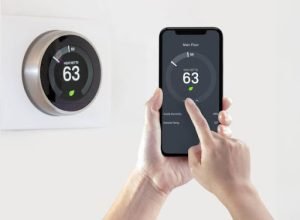In addition to saving the environment, conserving energy will not cost anyone a cent. Even though going green may seem like a trend, it’s here to stay. You can change your habits to help the environment and save money on utilities. It might take a little planning and commitment, but you can make simple changes that will add up over time. There are plenty of things and home goods. That you can do to make your home more energy-efficient, and it doesn’t have to cost a fortune.
-
Install Vinyl Windows


One of the quickest and easiest ways to improve your home’s energy efficiency is by replacing your wood for vinyl replacement windows. Replacing those old and outdated windows with new, energy-efficient vinyl windows will make a big difference in reducing the cost of heating and cooling your home.
-
Lighten Up with Solar Energy.


The next energy saving home goods that we would like to introduce here are Solar panels. It can help you save money on your electric bill and help you go green at the same time. There’s no reason not to install them. Solar energy is a clean, renewable power source that can be used for everything from generating electricity to heating water for your home. In addition to lowering electricity bills, solar panels can also increase the resale value of your home by as much as $20,000.
-
Turn Off/ Unplug Appliances You Aren’t Using.
Leaving electronics on stand-by doesn’t save energy and wastes money. Set up a charging station in your home office or family room and unplug devices when they’re fully charged. Even when they’re turned off, these devices still draw electricity, so unplugging them can be an easy way to save energy. Turn off lights when you leave a room, and turn off electronics when they’re not in use.
- Let the Sunlight In.


Some of the most cost-effective changes you can make to improve energy efficiency are ones that won’t cost you a dime: opening curtains and shades to let in sunlight during the day, then closing them at night to reduce heat loss through windows.
-
Insulate


Adding insulation to your attic or crawl space is one of the easiest ways to reduce your home’s energy use, especially if you live in an older house. Insulation helps keep warm air inside during winter and cool air inside during summer, says Greg Tanner, an associate professor of construction management at Brigham Young University in Provo, Utah.
-
Install A Smart Thermostat


Smart thermostats is another home goods that can automatically cut back on heating and cooling when no one is home or when outside temperatures switch— saving you money on your utility bills in the process. Set your thermostat a few degrees lower in the winter and a few degrees higher in the summer to save money on heating and cooling costs without sacrificing comfort.
-
Plant Shade Trees


Grow shade trees or shrubs on the sunny side of your home to keep it cool in the summer months, but avoid planting them too close to your home as tree roots can damage concrete foundations or sewer lines; also, falling leaves or branches could clog gutters or scratch siding or windows if they are too close together!
-
Clean Your Air Conditioner’s Filter


Clean filters not only reduce electricity use, but these home goods reduce the number of pollutants entering the air in your home. The U.S. Department of Energy says a dirty air conditioner filter makes the system work harder and uses more electricity. The bottom line is dirty filters mean bigger utility bills and fewer dollars in your pocket.
-
Use Compact Fluorescent Lightbulbs (Cfls)


CFLs use about 70 percent less energy, and they last up to 10 times as long as incandescent bulbs. The savings from using CFLs over incandescent bulbs is significant. Over the lifetime of one CFL, you could save about $30 in electricity costs by using these energy efficient home goods.
-
Buy Energy-Efficient Appliances


When buying new appliances, consider their energy efficiency as well as their features and price tag. The U.S. Environmental Protection Agency says that when you purchase Energy saving products, you’re helping to reduce greenhouse gas emissions by about 300 million metric tons each year — equivalent to the annual emissions of 80 million vehicles!
-
Take Shorter Showers – Especially Hot Ones.
A typical shower uses 10 to 15 gallons of water every five minutes. A warm or hot shower, however, can use between 50 and 70 gallons of water in that same time frame. When you’re taking a shower, make it quick and use cold water whenever possible.
-
Use Cold Water For Laundry And Dishes Whenever Possible


Heated water requires energy to heat it up, but most of the time it’s not necessary. After all, your dishwasher washes with hot water, but you rinse your dishes before putting them into the dishwasher – and that’s all you need to do! If your clothes are really dirty and require hot water, it’s best to set aside a load just for them on their own instead of mixing them in with other clothes in a normal wash cycle. Run full dishwasher and washing machine loads rather than several small loads throughout the week. It takes more energy to wash two small loads than one larger load.
-
Set Up Ceiling Fans


If you want to cool down during the summer months (or warm up during the winter months), fans can be an energy-efficient way to do so without having to turn on the air conditioner or heater – or at least turn them down a little bit while still maintaining your comfort levels. When using a ceiling fan in the summer months, you should run the fan counterclockwise
- Seal Windows


Seal windows by adding weather stripping, caulking, or storm windows to reduce drafts and cold spots around doors, windows, and other openings to the outdoors. Look for drafts by holding a candle near areas where two different building materials meet (such as where the window frame. Cover windows with shades, drapes, or blinds to keep out the heat during the summer months and cold air during the winter months. Close shades before you leave your home as well.
The Takeaway
It’s never been more important to be energy efficient. Not only are you saving money, but you’re also helping the surroundings and contributing to a cleaner planet. Investing in energy-efficient home improvements not only helps reduce your utility bills but also increases your home’s value and makes it more attractive to potential buyers.
As you can see, building power-efficient houses isn’t all too complicated. There are basic measures that can be taken, and you don’t have to do it all simultaneously. And it might actually be a good strategy for you to undertake a few adjustments every now and again to strive toward this approach without overburdening.
READ NEXT: Living room interior design and furniture ideas
RELATED TOPICS: home interior design ideas






